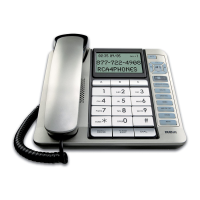
Do you have a question about the RCA 1114 and is the answer not in the manual?
Equipment approval, REN, and telephone company notification requirements.
Telephone company rights regarding network trouble caused by equipment.
Device compliance with FCC Part 15, radio frequency energy, and interference guidelines.
Covers Hearing Aid Compatibility, FCC RF Exposure, and Industry Canada notices.
Essential safety precautions for using the telephone to prevent injury and damage.
Welcome, safety warnings, parts checklist, and initial setup requirements.
Specification of the required telephone jack for installation.
Important safety and procedural information for installing the telephone.
Detailed instructions for setting up the telephone on a desktop surface.
Guide to detach the desktop base and mount the phone on a wall.
Instructions for safely relocating the answering machine to a new location.
Steps to record a personalized outgoing announcement for the answering system.
How to listen to and verify the recorded outgoing announcement.
Using the speakerphone, answering/making calls, switching modes, and flash functions.
How to redial the last number and use the mute function.
Overview of customizable settings like rings, message length, and quality.
Configuring the number of rings before answering and using the Toll Saver feature.
Adjusting incoming message duration and recording quality settings.
Setting the remote access security code and adjusting display contrast.
Entering the local area code for features like dial-back.
Choosing between touch-tone and pulse dialing modes.
Configuring the day of the week, time, and date for accurate logs.
Adjusting language, message, ringer, handset, and speakerphone volume levels.
Information on subscribing to Caller ID and Call Waiting Caller ID services.
Explanation of the summary screen display after receiving a new call.
How to manage incoming calls while already on a call using the Flash/Exit button.
Procedures for receiving, storing, reviewing, and deleting Caller ID records.
Steps for redialing numbers from Caller ID records, considering the local area code.
Steps for redialing numbers when the local area code is not programmed.
Detailed guide on saving phone numbers and associated names into memory locations.
Saving redial numbers and deleting stored memory entries.
Transferring Caller ID entries into user-defined memory slots.
Inserting pauses, changing stored numbers, dialing from memory, and reviewing entries.
Using memory to dial sequences for calls like long distance services.
How the answering system handles incoming calls and call screening.
Functionality of auto disconnect and how to play, stop, and restart messages.
Methods for deleting messages and recording personal memos.
Managing full memory and accessing the answerer remotely.
List and explanation of commands for remote operation.
Understanding message indicators and troubleshooting phone issues like no dial tone.
Troubleshooting common problems with the answering system.
Solutions for incomplete messages, remote command failures, answerer issues, and error messages.
Advice on cleaning, maintaining, and protecting the product.
Identifying factors that can negatively impact reception quality.
Steps and requirements for getting warranty service for the product.
Explanation of what the limited warranty covers and for how long.
Details on shipping for service, warranty exclusions, and limitations.